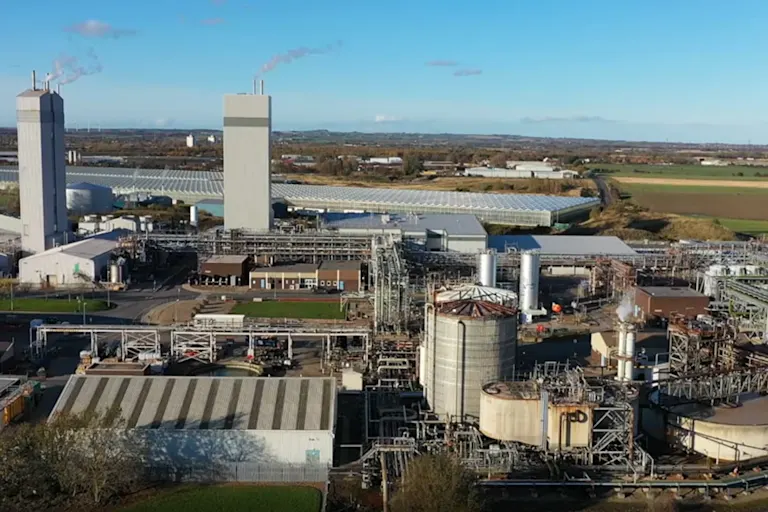Mycoprotein: Healthy protein for people and planet
How does the food we eat impact the environment? And how can mycoprotein be part of the solution?
Written by Khanh Mach, Sustainability Specialist at Quorn Foods

All our actions have an impact on the environment, from the phone we use, to the food we eat. The food industry is responsible for a third of global greenhouse gas emissions.1 Agriculture takes up almost half of the world's habitable land. Of this land, 77% is used for growing animal feed and livestock, despite animal protein only providing 18% of the world's calories and 37% of protein needed.2
The environmental impacts of the food industry
Approximately 70% of global freshwater is used for agriculture.3 The UK imports a large amount of fruits and vegetables from overseas: 80% of the counties from where they are sourced are drought prone.4 Globally, beef and soya, especially soya used as animal feed, are the key drivers of tropical deforestation.5
The need for animal feed and raising the animals themselves represents a burden on mother Earth. If the world population can switch to a more meat-free diet, we can eliminate the demand of clearing land for grazing.
It is worth remembering that all lives on Earth rely on nature. If there is no nature, there would not be resources to produce anything, including our food, which means there would be no more human life on this planet.
Environmental impacts of mycoprotein
Shifts to vegetarian or vegan diets, or diets lower in meat can be part of the solution towards improving the health of our planet. It has been modelled and proven that meat alternatives have twice as low environmental impacts as animal-based foods.6 Let’s zoom in. How does mycoprotein perform compared to other sources of proteins?

Is mycoprotein a sustainable protein source?
Mycoprotein is a very land-light protein. It is grown in 40-meter-high airlift fermenters in the Northeast of England. This allows mycoprotein production to be scaled up with low land demand. A study published by Potsdam Institute for Climate Impact Research has shown that swapping just 20% of global beef consumption for microbial protein, like mycoprotein, could halve deforestation and greenhouse gas emissions associated with it in the next 30 years.7
Mycoprotein also has lower carbon, land and water footprints compared to animal proteins and some plant-based proteins. Growing Quorn mycoprotein requires at least 62% less land than chicken, consumes 86% less water than pork and produces 98% fewer greenhouse gas emissions than beef.8 The carbon footprint of Quorn mycoprotein is also at least 55 times lower than beef.
It does not mean all efforts stop there. At Quorn Foods, work continues to further reduce the impacts of Quorn mycoprotein on the environment. In 2021, there was a moved to renewable energy at the home of mycoprotein, which immensely reduced the carbon footprint of mycoprotein by 30% compared to the previous footprint verification. Furthermore, operational emissions reduced by 84% between 2012 and 2023, but with the belief that what is good can always be better, Quorn Foods are continuing to explore routes to decarbonisation to reach their net zero by 2030 target for own operations.
If you want to dig deeper in data, below is the table summarising the environmental performance of mycoprotein in comparison to other sources of proteins.
*Carbon footprint assesses all greenhouse gases released during the production of these proteins with the ‘cradle-to-gate’ boundary. For mycoprotein, this includes the emissions associated with all ingredients, transport and process. For animal proteins, this includes emissions associated with the cultivation of feeds, emissions released in the rearing and processing stages of the animals. For plant-based proteins, this includes emissions released when growing the raw materials and processing into the protein concentrate.
Land footprint focuses on the physical area required to produce the finished product. For animal proteins, this involves the area that livestock is raised on and where their feeds are grown. For meat-alternative proteins, this involves the land required to grow the crops and the area of production.
Blue water footprint assesses the total amount of water used during the processes required to produce the finished product. Blue water is the most important footprint for direct comparisons as it can be controlled by businesses. Meanwhile, green water footprint is the rainwater coming down on crops and grey water is the amount of water needed to dilute pollution and already regulated by water quality laws in Europe.
Read more in the Quorn Footprint Comparison Report (The Carbon Trust, 2023).
Do I need to compromise my health for the health of our planet?
Short answer is luckily no!
The 2021 blueprint for a National Food Strategy suggested cutting meat consumption by 30% as one of the changes needed by 2032 to meet the UK Government’s existing targets on health, climate and nature.11 Reducing meat consumption, particularly red and processed meat consumption, can lower risk of chronic diseases such as heart disease, type 2 diabetes, and certain cancers. Vegetarian and vegan diets are typically high in fibre, full of vitamins, low in saturated fats and supportive to your gut health, which are all key for health.12
The Eatwell Guide, as well as the British Dietetic Association’s One Blue Dot, Environmentally Sustainable Diet project, recommend a healthy, balanced and sustainable diet with less meat, especially red and processed meat, and substituting animal proteins with more non-animal proteins such as mycoprotein and plant-based proteins.
Furthermore, it has been shown that adherence to Eatwell Guide would lead to a 30% lower environmental footprint than the current British diet and can also reduce the risk of total mortality by 7% compared with those who have a very low adherence to the recommended diet, despite the fact that the Eatwell Guide didn’t consider sustainability whilst being developed.13,14
In conclusion, a diet that has reduced meat and includes mycoprotein can benefit both your health and the health of our planet. Isn’t that a win-win solution?
About the author
Khanh Mach is a Sustainability Specialist at Quorn Foods. Her work covers a wider breadth of sustainability, from environmental to social impacts, and how to encourage colleagues to support the company’s net positive journey. She’s responsible for the company's entire product carbon footprint portfolio, and the development and implementation of Quorn Foods' modern slavery statement. Khanh also design tools fostering colleagues to infuse sustainability into new product development. Collaborating with her team, she spearheads a colleague group dedicated to advancing sustainability topics, bringing everyone together to help Quorn Foods achieve its net positive ambition by 2030.
References
¹Xu, X., Sharma, P., Shu, S., Lin, T.-S., Ciais, P., Tubiello, F.N., Smith, P., Campbell, N. and Jain, A.K. (2021). Global Greenhouse Gas Emissions from Animal-based Foods are Twice Those of plant-based Foods. Nature Food, [online] 2(9), pp.724–732. Available at: https://www.nature.com/articles/s43016-021-00358-x.
²Ritchie, H. and Roser, M. (2024). Half of the world’s habitable land is used for agriculture. [online] Our World in Data. Available at: https://ourworldindata.org/global-land-for-agriculture.
³Unesco (2024). Statistics. [online] Unesco.org. Available at: https://www.unesco.org/reports/wwdr/en/2024/s.
⁴WRAP. (n.d.). Food and drink. [online] Available at: https://www.wrap.ngo/taking-action/food-drink.
⁵WWF. (2020). Our 10 myths about deforestation. [online] Available at: https://www.wwf.org.uk/10-myths-about-deforestation#:~:text=Meat%20production%20is%20a%20particularly [Accessed 13 Aug. 2024].
⁶Smetana, S., Ristic, D., Pleissner, D., Tuomisto, H.L., Parniakov, O. and Heinz, V. (2023). Meat substitutes: Resource demands and environmental footprints. Resources, Conservation and Recycling, 190, p.106831. doi:https://doi.org/10.1016/j.resconrec.2022.106831.
⁷Humpenöder, F., Bodirsky, B.L., Weindl, I., Lotze-Campen, H., Linder, T. and Popp, A. (2022). Projected environmental benefits of replacing beef with microbial protein. Nature, [online] 605(7908), pp.90–96. doi:https://doi.org/10.1038/s41586-022-04629-w.
⁸The Carbon Trust (2023). Quorn Footprint Comparison Report. Available at: https://www.quorn.co.uk/assets/files/content/Carbon-Trust-Comparison-Report-2023.pdf.
⁹Van Mierlo et al. (2017) A model for composing meat replacers: Reducing the environmental impact of our food consumption pattern while retaining its nutritional value. Journal of Cleaner Production 16S: 930-950
¹⁰Shahid, M., Shah, P., Mach, K., Rodgers-Hunt, B., Finnigan, T., Frost, G., Neal, B. and Michalis Hadjikakou (2024). The environmental impact of mycoprotein-based meat alternatives compared to plant-based meat alternatives: a systematic review. Future Foods, pp.100410–100410. doi:https://doi.org/10.1016/j.fufo.2024.100410.
¹¹CHAPTER 16 Independent Review. (n.d.). Available at: https://www.nationalfoodstrategy.org/wp-content/uploads/2021/07/National-Food-Strategy-Chapter-16.pdf.
¹²Dinu, M., Abbate, R., Gensini, G. F., Casini, A., & Sofi, F. (2017). Vegetarian, vegan diets and multiple health outcomes: A systematic review with meta-analysis of observational studies. Critical Reviews in Food Science and Nutrition, 57(17), 3640-3649. doi:10.1080/10408398.2016.1138447
¹³The Carbon Trust (2016). The Eatwell Guide: a More Sustainable Diet. [online] UK: The Carbon Trust. Available at: https://ctprodstorageaccountp.blob.core.windows.net/prod-drupal-files/documents/resource/public/The%20Eatwell%20Guide%20a%20More%20Sustainable%20Diet%20-%20REPORT.pdf.
¹⁴Scheelbeek, P., Green, R., Papier, K., Knuppel, A., Alae-Carew, C., Balkwill, A., Key, T.J., Beral, V. and Dangour, A.D. (2020). Health impacts and environmental footprints of diets that meet the Eatwell Guide recommendations: analyses of multiple UK studies. BMJ Open, [online] 10(8), p.e037554. doi:https://doi.org/10.1136/bmjopen-2020-037554.